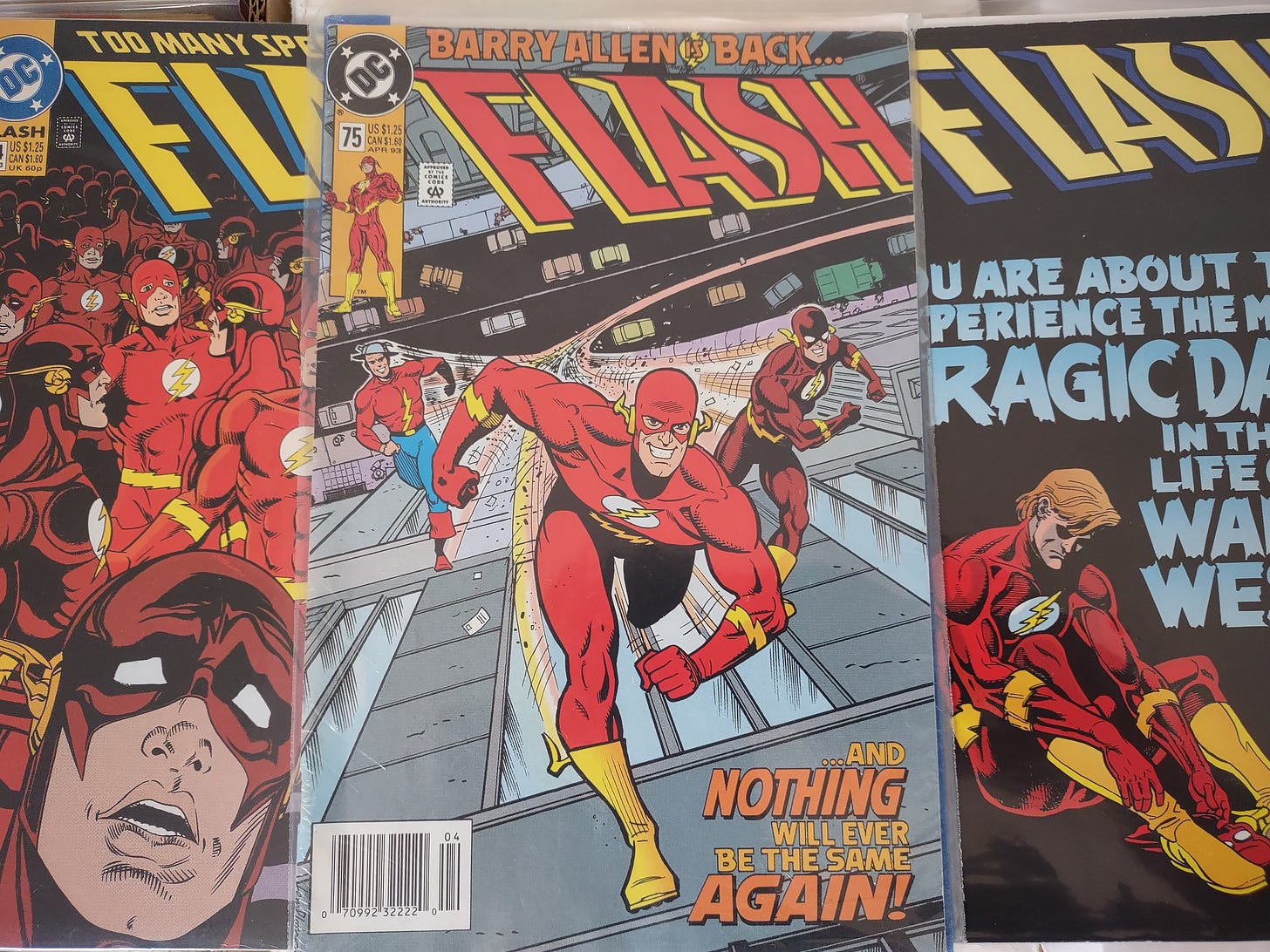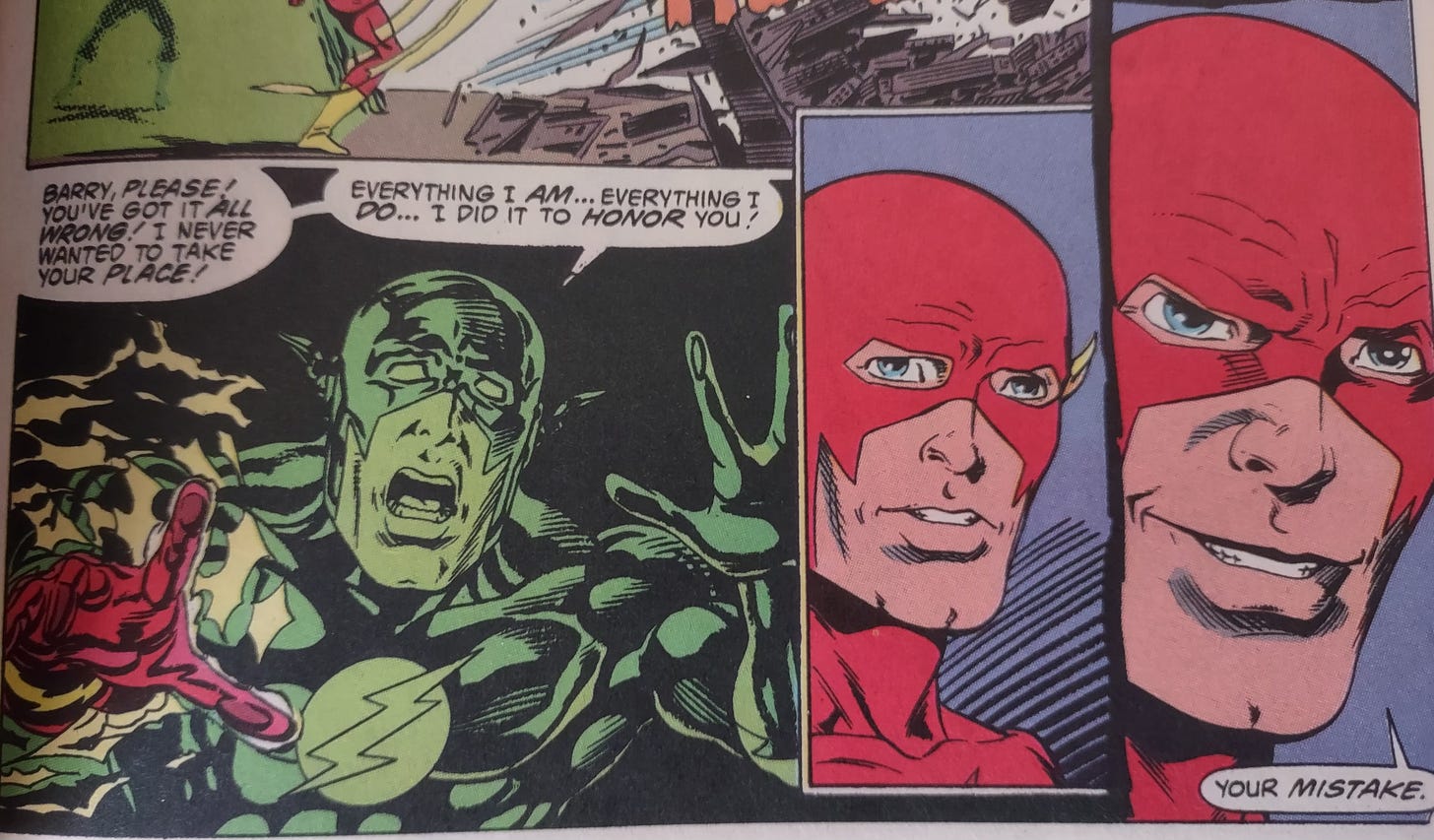The Legacy of the Flash
Looking back at the storyline that showed me how great comics could be.
When does a casual interest solidify into a lifelong hobby?
I started reading comic books when I was eight, thanks to the gateway drug known as the Teenage Mutant Ninja Turtles. The cartoon led me to the Archie comics in 1991. A year later, the Adam West Batman show hooked me and got me to pick up an issue of Detective Comics.
Cartoons, campy ’60s shows, action figures, and video games eventually fell by the wayside as I grew up, but my comic book habit persisted without interruption. And it still persists over three decades later.
If I had to guess the storyline that locked me in as a lifelong fan, it would be “The Return of Barry Allen,” which ran in Flash #74-79 in 1993, written by Mark Waid and drawn by Greg LaRocque.
Since I started with Batman, you might think Superman would be the natural choice for my second non-turtle superhero. No, Superman was third; he lost the race for second to the Flash. That shiny red costume drew my young eye starting with Flash #69, which featured a crossover with Green Lantern (thereby accounting for GL becoming superhero #4, but I couldn’t tell you who #5 was since my interest pretty much exploded after that).
While my earliest Flash issues were great fun, #74-79 were a game changer. In these issues, the previous Flash, Barry Allen, apparently returns from the dead and reclaims the mantle. It’s initially a dream come true for the current Flash, Wally West (who previously served as Barry’s sidekick, Kid Flash). Barry’s return gives Wally a minor identity crisis, but that’s a small price to pay for having his uncle and mentor back.
Soon, however, Barry displays some concerning behavior, and it becomes clear that this is not the heroic Barry Allen who helped found the Justice League and sacrificed himself to save the universe. It’s not Barry Allen at all, but a villain who’s trying to tarnish the hero’s memory and corrupt his legacy.
Wally cycles through an array of emotions throughout the storyline. He’s thrilled, but then the doubts start creeping in. When “Barry” commits his heel turn, it shatters Wally’s entire sense of purpose and plunges him into despair. Wally had, after all, become the Flash to honor his uncle’s example of selfless heroism, but now his role model is proving himself to be neither selfless nor heroic.
But when Wally pieces together the truth, it re-motivates him, and he’s more determined than ever to protect Barry’s legacy—even if it sets him on a path to surpassing his mentor someday.
This was no villain-of-the-month, paint-by-numbers hack job. Neither were the previous comics I read, but this storyline in particular showed me how creative and versatile superhero storytelling could be. It was clearly about something—it played with themes about role models, growing up, and legacies that translate into the real world. “The Return of Barry Allen” isn’t about Barry at all. It’s about Wally West, and it cuts to the heart of his motivation as he strives to live up to an ideal.
This Flash series, from #1 all the way through the final issue about 20 years later, was essentially one long coming-of-age story. The first issue reintroduced Wally as a self-centered 20-year-old. From there, he gradually developed into a responsible and respected superhero and then eventually settled down as a devoted family man. The entire time, he looked to his uncle’s example of selfless service and sacrifice as the ideal to aspire toward. Wally became a far more interesting Flash than Barry, who was perfectly noble from the get-go and had no specific reason for becoming a superhero. Barry Allen got powers; therefore, he became a superhero.
Barry was a great superhero, yes, and built from the classic mold. But Wally was a dynamic superhero. “The Return of Barry Allen” presented a pivotal chapter of his maturation.
This story also made the same points that Superman and Batman comics were making at the same time: It’s not the costume that matters. It’s not the powers or skills that matter. It’s the person within the costume and how he or she uses those powers.
Superman comics did it with “The Death of Superman,” “Funeral for a Friend,” and “The Reign of Supermen,” and Batman comics had “Knightfall,” “Knightquest,” and “KnightsEnd.” While those storylines had a lot of good stuff and Superman’s death received plenty of media attention, Flash’s storyline was tighter and more focused. And, important for me at the time, it didn’t replace the main character for several issues. (I had no interest in spending what little money I had to read about a Superman who wasn’t Clark Kent or a Batman who wasn’t Bruce Wayne, even though I now appreciate the spirit with which it was all intended.)
Plus, “The Return of Barry Allen” showed me how much history these stories contain. There was this whole decades-long mythology building up before I ever grabbed my first issue. Barry wasn’t even the first Flash, for instance—back in the 1940s, there was Jay Garrick, who co-stars here in an elder statesman role. Comics opened my eyes to fictional history, then real-world publication history, and eventually broader real-world history. Events that happened long ago still matter and are still worth knowing. This was probably an accidental lesson here, but an important one nevertheless.
I read some good comics before this and countless excellent ones after, but “The Return of Barry Allen” will always be the first great comic book storyline I ever read.




I love stories about Doppelgängers and characters who are mirror images of each other. And I love stories about mentors who teach young heroes to grow and mature. This story has both themes mixed together in a truly unique fashion.
It’s the best Flash story ever done. https://tombrevoort.com/2020/02/17/perfect-game-flash-79/